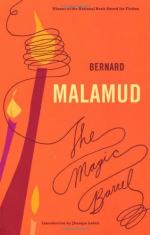|
This section contains 685 words (approx. 3 pages at 300 words per page) |

|
SOURCE: "Comic Vision and the Theme of Identity," in Bernard Malamud and the Critics, edited by Leslie A. Field and Joyce W. Field, New York University Press, 1970, pp. 151-70.
In the following excerpt from an essay originally published in Critique, Goldman interprets "The Magic Barrel" as a fantastical parable centering on Finkle's journey of self-discovery.
[In several of his tales] Malamud deliberately avoids a realistic social setting for the comic parable or fantasy leading to the moment of self-recognition and reality. Thus, in two stories from The Magic Barrel, the title story and "Angel Levine," Malamud uses fantasy as a controlling frame for his mixture of the comic and the serious. The two symbolic characters, Salzman and Levine, matchmaker and Negro-Jewish angel, serve also as comic archetypes or subconscious doubles, those other-selves familiar to readers of Dostoevsky, Conrad, Kafka, and other masters of the modern psyche. This motif...
|
This section contains 685 words (approx. 3 pages at 300 words per page) |

|


